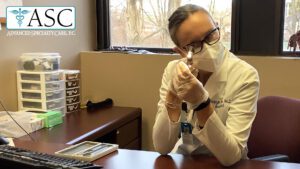19 years ago when I was in graduate school studying Audiology, most hearing aids had a volume wheel. Perhaps you remember a family member turning their hearing aids down when they were whistling. By twisting a wheel forward or backward, the hearing aid got louder and softer. Hearing aids did not have automatic gain control so the patient had to adjust the volume to keep sound audible but comfortable. This lead to a constant up-and-down manipulation of the hearing aids throughout the day.
Next, hearing aid companies gradually introduced a program button. Instead of adjusting the volume incrementally, patients could have separate settings for noise, quiet, television, restaurant, etc. Some hearing aids had 4 or more programs, that the patient could access by pressing a button. This still required the patient to interact with the hearing aid throughout the day.
About 7 years ago technology improved in hearing aids to the point where patients didn’t need to manually adjust their hearing aids very much. New devices could focus sound in the direction of speech and reduce noise from several locations at once. The days of volume control and memory buttons were over. Most often, patients were able to put their hearing aids in and leave them alone. It was so much easier for patients with limited manual dexterity to “set them and forget them.”
More recently, the pendulum has swung back toward manual control for patients who want it. Even though hearing aids have even more automatic features and can adapt to a myriad of listening environments automatically, some patients are choosing to manually control their hearing aids again. The reason for this is that many hearing aids now connect to an app. Most new hearing devices have Bluetooth which allows them to be controlled by an app on a cell phone. Our more tech savvy patients love being able to open the app and make adjustments to noise reduction or change settings.


I often encourage patients to wear their new hearing aids for a month before loading the app, just to get used to the automatic adjustments before trying to make manual changes.
Hearing aids have improved tremendously over the last two decades, with new Bluetooth technology giving patients the flexibility to adjust their sound quality if they choose to. While patients no longer need to have such meticulous control over their volume or listening programs, merely having the option available to them is in & of itself a show of how far the industry has progressed.


Dr. Jocelyn Doré is a board-certified Audiologist treating adult & pediatric patients in our Danbury & New Milford offices
ADVANCED SPECIALTY CARE
Call (203) 830-4700 to schedule an appointment with one of our Audiology specialists at any of our convenient office locations in Danbury, New Milford, Norwalk and Ridgefield, CT.
Related Blogposts


At Advanced Specialty Care, our Clinical Audiologists do more than ensure you hear well – we focus on your total hearing health. Our affiliation with ASC’s Ear, Nose & Throat specialists ensures a comprehensive approach to healthy hearing. We offer state-of-the-art instrument technology and qualified professionals.

